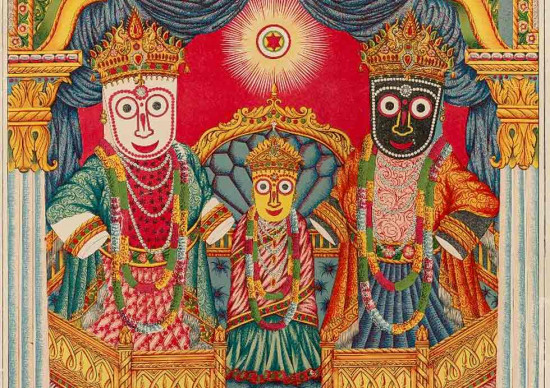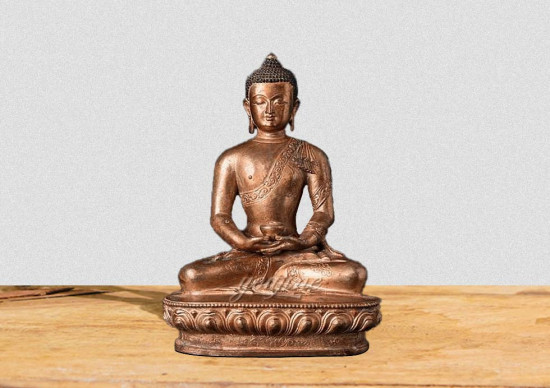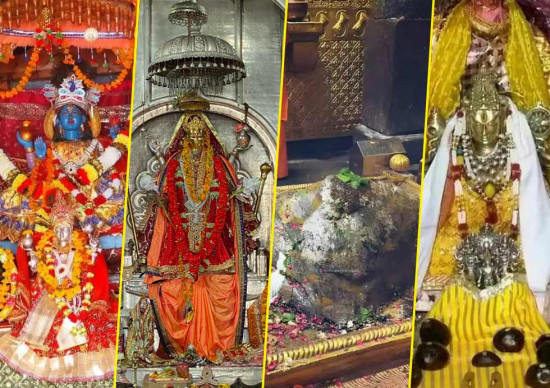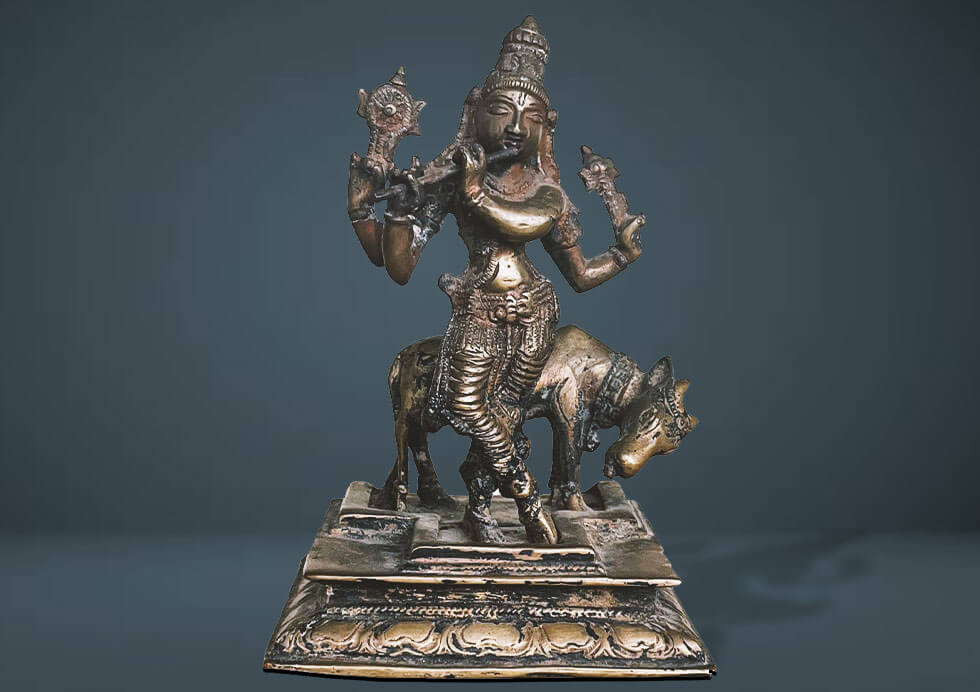
Lord Krishna is known by many names, including Shyam, Kanha, and Gopala. He is also called Venugopal, reflecting his connection to the flute, or venu in Sanskrit. The name "Venugopal" combines two parts: Venu, meaning "flute," and Gopal, meaning "protector of cows." Thus, Venugopal means "the protector who plays the flute," highlighting Krishna’s special bond with his flute and his role as a caretaker.
Hindu scriptures are filled with captivating legends about Krishna's flute, or murali. It is said that the flute was crafted in the divine realms by celestial artisans. As Krishna grew, he dedicated himself to mastering this sacred instrument. The music from his flute was believed to possess a magical quality that could touch the hearts of people, animals, and even nature itself.
Krishna’s flute is more than just a musical tool; it is thought to carry a spiritual essence that connects with the divine. Krishna and his flute are inseparable, and Krishna playing his flute is one of the most beloved themes in Indian art, frequently depicted in statues and paintings.
Hindu scriptures are filled with captivating legends about Krishna's flute, or murali. It is said that the flute was crafted in the divine realms by celestial artisans. As Krishna grew, he dedicated himself to mastering this sacred instrument. The music from his flute was believed to possess a magical quality that could touch the hearts of people, animals, and even nature itself.
Krishna’s flute is more than just a musical tool; it is thought to carry a spiritual essence that connects with the divine. Krishna and his flute are inseparable, and Krishna playing his flute is one of the most beloved themes in Indian art, frequently depicted in statues and paintings.
Who Gave the Flute to Lord Krishna?

There are several fascinating stories about Lord Krishna's flute. One story says that Krishna used his divine powers to turn a simple bamboo stick from the Yamuna River into his magical flute. This flute was so special that its music could enchant everyone, including the gods and the universe.
Another tale tells that the wise sage Narada, who was known for his love of music, made the flute and gave it to Krishna, believing his melodies would charm the entire cosmos.
There's also a story where Lord Shiva created the flute from the bones of the sage Dadhichi, who had given up his life for a greater cause. When Lord Vishnu incarnated on Earth as Lord Krishna during the Dwapara Yuga, deities from various realms came to Earth in different forms to see him. Among them, Lord Shiva also wanted to meet Krishna and thought about what gift would please him and be cherished.
Shiva remembered that he had the powerful bones of Sage Dadhichi. So, he decided to carve a beautiful flute from these bones. Shiva then went to Gokul and presented the flute to Lord Krishna as a gift.
Another tale tells that the wise sage Narada, who was known for his love of music, made the flute and gave it to Krishna, believing his melodies would charm the entire cosmos.
There's also a story where Lord Shiva created the flute from the bones of the sage Dadhichi, who had given up his life for a greater cause. When Lord Vishnu incarnated on Earth as Lord Krishna during the Dwapara Yuga, deities from various realms came to Earth in different forms to see him. Among them, Lord Shiva also wanted to meet Krishna and thought about what gift would please him and be cherished.
Shiva remembered that he had the powerful bones of Sage Dadhichi. So, he decided to carve a beautiful flute from these bones. Shiva then went to Gokul and presented the flute to Lord Krishna as a gift.
Iconography of Krishna as Venugopal
Central to Krishna as Venugopal form is, of course, the divine flute. Krishna is typically depicted holding a long, slender flute, often made of bamboo or ivory in artistic representations. This motif of Krishna as Venugopal with cows is very popular in art. His posture varies, but commonly includes a standing or seated position with legs crossed in a meditative pose. The flute is held either horizontally, with both hands, or vertically, with one hand. Krishna Venugopal
Krishna's attire is another key element. He is often adorned with elaborate jewelry, including necklaces, earrings, and armlets. His clothing, usually a dhoti, is simple yet elegant. The divine figure is often depicted with a serene expression, eyes closed in contemplation, or with a gentle smile as he plays the flute.
Krishna's attire is another key element. He is often adorned with elaborate jewelry, including necklaces, earrings, and armlets. His clothing, usually a dhoti, is simple yet elegant. The divine figure is often depicted with a serene expression, eyes closed in contemplation, or with a gentle smile as he plays the flute.
- Flute (Venu): Central to this portrayal is Krishna’s flute, or venu. He is often shown playing this divine instrument, which symbolizes his connection with the spiritual and natural worlds. The flute is usually held to his lips, producing melodious music that enchants all who hear it.
- Attire and Decorations: Krishna is usually adorned with traditional clothing, including a bright yellow dhoti. His attire is often complemented by a variety of ornaments, such as a crown, necklaces, and armlets. These embellishments emphasize his royal and divine status.
- Playful Posture: Krishna is often depicted in a relaxed, playful pose, conveying his joyful nature. His posture may show him leaning slightly to one side while playing the flute, embodying a sense of ease and musical bliss.
- Surroundings: The setting in these depictions often includes lush natural surroundings, such as forests or pastoral scenes, reflecting Krishna’s deep connection with nature. Sometimes, animals and gopis (female devotees) are shown around him, captivated by the music.
- Facial Expression: Krishna’s expression is typically serene and blissful, capturing the essence of divine love and tranquility. His gaze is often directed towards the viewer or his flute, inviting contemplation and connection.
- Aura or Halo: A glowing aura or halo may surround Krishna, signifying his divine nature and the spiritual energy emanating from him.
Regional Variations
Krishna Venugopal statues or painting forms have undergone regional variations, with different artistic styles and interpretations emerging across India. For example:
- Bengal: Bengali artists often depict Venugopal with a more delicate and elongated form, emphasizing the lyrical quality of Krishna's music.
- Rajasthan: Rajasthani Venugopals are known for their vibrant colors and intricate details, reflecting the region's rich artistic heritage.
- South India: South Indian Venugopals often exhibit a more robust and majestic appearance, with a focus on the divine power and grandeur of Krishna.
Cultural Significance
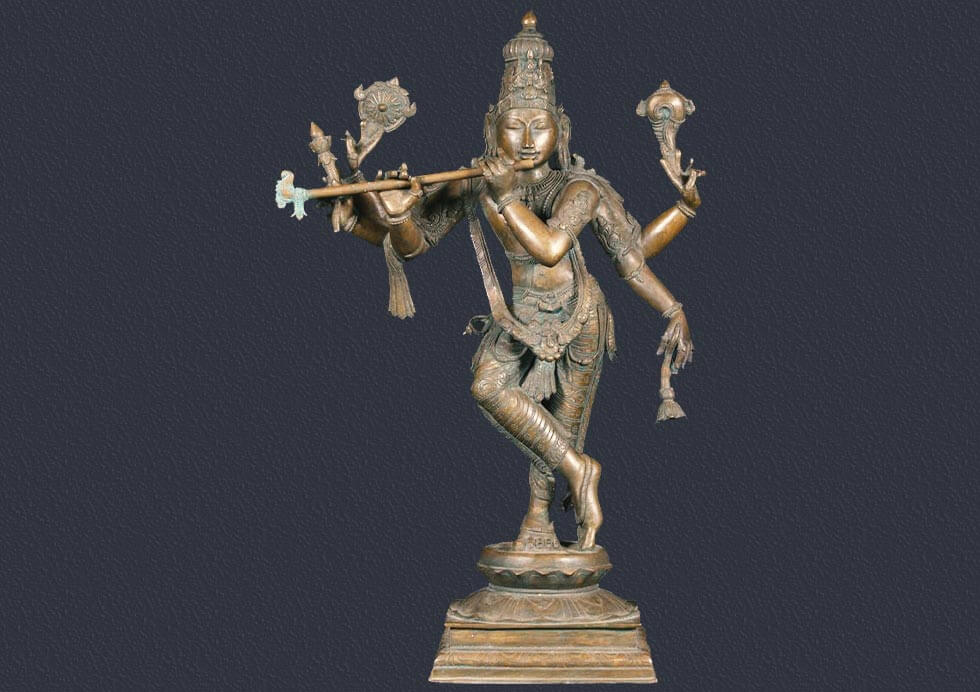
Venugopal, with Krishna playing his flute, has inspired poets, musicians, and artists for centuries. This form is more than just a depiction; it has become a powerful symbol deeply embedded in Indian culture. The sight of Krishna with his flute represents love and devotion, capturing the essence of divine music that touches the heart.
Artists have long been fascinated by Krishna's enchanting flute music, which they interpret in their work through paintings, sculptures, and literature. The form of Krishna playing the flute evokes feelings of beauty and spirituality, highlighting the deep connection between the divine and the human spirit.
For many, this form is a reminder of the power of music to connect with the divine and to express profound emotions. It reflects the timeless appeal of Krishna's divine presence and the lasting influence of his melodious tunes on Indian culture.
Conclusion
Krishna as Venugopal is a masterpiece of Indian sculpture that encapsulates the essence of divine beauty and spiritual devotion. Its intricate craftsmanship, profound symbolism, and enduring appeal make it a treasure trove for art lovers, religious scholars, and spiritual seekers alike. As we continue to explore the rich tapestry of Indian culture, the Venugopal stands as a shining example of the artistic and spiritual achievements of a bygone era.
Artists have long been fascinated by Krishna's enchanting flute music, which they interpret in their work through paintings, sculptures, and literature. The form of Krishna playing the flute evokes feelings of beauty and spirituality, highlighting the deep connection between the divine and the human spirit.
For many, this form is a reminder of the power of music to connect with the divine and to express profound emotions. It reflects the timeless appeal of Krishna's divine presence and the lasting influence of his melodious tunes on Indian culture.
Conclusion
Krishna as Venugopal is a masterpiece of Indian sculpture that encapsulates the essence of divine beauty and spiritual devotion. Its intricate craftsmanship, profound symbolism, and enduring appeal make it a treasure trove for art lovers, religious scholars, and spiritual seekers alike. As we continue to explore the rich tapestry of Indian culture, the Venugopal stands as a shining example of the artistic and spiritual achievements of a bygone era.



